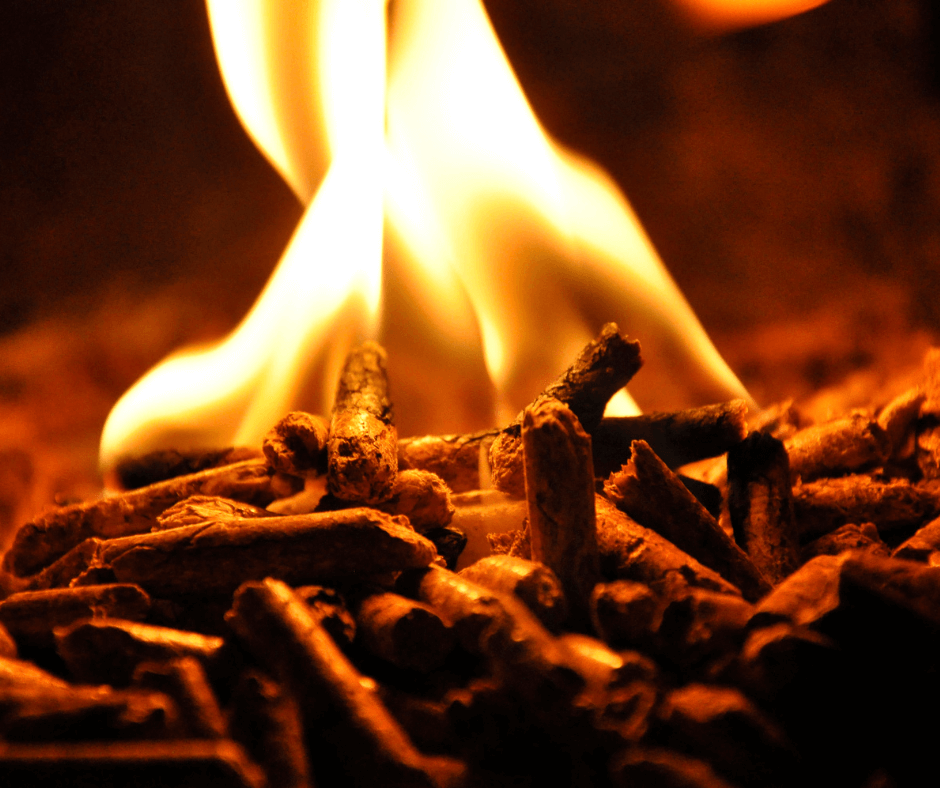Due to high oil and gas costs and growing environmental concerns, many homeowners turn to biomass fuels as a clean heating alternative. Pellet stoves are one option instead of oil, gas or electric heat. This blog post will explain what pellet stoves (and their fuel—wood pellets) are, and the pros and cons of using wood pellets as a heat source.
What Are Pellet Stoves?

Pellet stoves are a heating source powered by burning a renewable biomass fuel called pellets. Compared to a traditional heating fuel such as oil, gas or electric, this home heating alternative is an excellent option for homeowners who want to save money on their energy bills while reducing their carbon footprint.
Pellet appliances come in two forms: stoves and inserts. Pellet stoves are freestanding heating units that sit on a hearth pad, whereas pellet inserts are firebox units installed into a current traditional fireplace space. Between stoves and inserts, there are many different types of pellet heating units on the market, varying in different styles, heat outputs and sizes.
How Are Wood Pellets Sourced and Made?
The lifecycle of a wood pellet, from creation to use, centers around sustainable practices. Pellets are composed of biomass materials such as wood chips, bark sawdust, and other byproducts that would otherwise end up in a landfill. By harnessing these byproducts, wood pellet manufacturers can turn something that otherwise would be discarded into heating fuel.
After collecting the biomass byproduct, a hammer mill grinds the raw material, then presses it through molds into a uniform size, shape and density. As the pellets cool, the moisture content is reduced to four to eight percent, hardening the pellets. Because of the low moisture content, these pellets provide long-burning, consistent heat with minimal emissions.
Benefits of Wood Pellets
Pellet fuel is a win-win-win: saving money, saving the atmosphere and saving effort. It's good for you and even better for the environment.
Cost Efficient
One of the main drivers for homeowners to switch to pellet fuel is cost efficiency. With oil and electric costs rising, pellet fuel remains virtually unaffected by the market's volatility. Since they are a renewable fuel, biomass products, such as pellets, are not only a sustainable option but also inexpensive. Depending on the stove size and your home, a pellet stove could heat up to 2,500 square feet for as little as $5 per day. Visit our cost-savings calculator to learn how much you can save by switching to pellet fuel.

Convenient
In a world that doesn't stop moving, convenience is a commodity. It's the same when it comes to your home heating. Unlike other heating methods like wood, you do not have to worry about strenuous manual labor. Leave cutting and hauling firewood in the past by simply refilling your pellet stove as needed with the ease of bagged wood pellets. Merely purchase your pellets from a dealer or distributor and store them in a dry area, such as your basement or garage.
In addition, many pellet stove owners opt to display their pellets in the same room as their stove for easy access and an added decorative element to their hearth.
Locally Sourced
Pellets used in the United States and Canada are manufactured within North America, providing a reliable source of fuel all winter. With many local suppliers and dealers, finding pellets near you is easy and convenient.
Sustainable
As mentioned, one of the biggest drivers of pellet fuel popularity is its sustainable benefits. As a renewable resource, pellets use waste material that would otherwise end up in a landfill and extracts its energy to provide reliable, radiant heat to millions of homes across the United States. Using pellet fuel, homeowners are reducing their carbon footprint by investing in a carbon-neutral heating alternative. Good for your health, good for the planet.
Additionally, qualifying wood and pellet stoves and inserts earn a federal biomass tax credit as an added benefit for investing in a sustainable heating alternative.
Next Steps
Considering the benefits of pellet fuel, it is no surprise that millions of Americans are opting for a cost-efficient, sustainable fuel choice. From their origin to their final burn, wood pellets are breaking the cycle of harmful emissions, one household at a time. Visit one of Quadra-Fire's local dealers to learn more about minimizing your carbon impact and energy bill. Your wallet and the planet will thank you!






